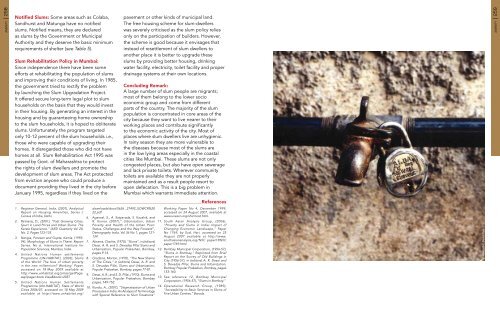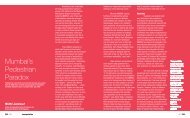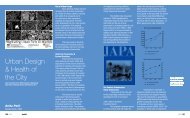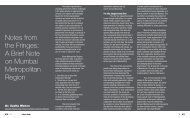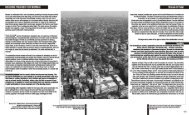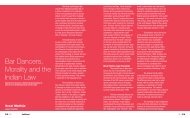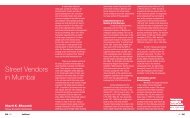Access to Civic Amenities in Slums of Mumbai.pdf - Urban Design ...
Access to Civic Amenities in Slums of Mumbai.pdf - Urban Design ...
Access to Civic Amenities in Slums of Mumbai.pdf - Urban Design ...
- No tags were found...
Create successful ePaper yourself
Turn your PDF publications into a flip-book with our unique Google optimized e-Paper software.
AMENITY | 258Notified <strong>Slums</strong>: Some areas such as Colaba,Sandhurst and Matunga have no notifiedslums. Notified means, they are declaredas slums by the Government or MunicipalAuthority and they deserve the basic m<strong>in</strong>imumrequirements <strong>of</strong> shelter (see Table 5).Slum Rehabilitation Policy <strong>in</strong> <strong>Mumbai</strong>:S<strong>in</strong>ce <strong>in</strong>dependence there have been someefforts at rehabilitat<strong>in</strong>g the population <strong>of</strong> slumsand improv<strong>in</strong>g their conditions <strong>of</strong> liv<strong>in</strong>g. In 1985,the government tried <strong>to</strong> rectify the problemby launch<strong>in</strong>g the Slum Upgradation Project.It <strong>of</strong>fered secure long-term legal plot <strong>to</strong> slumhouseholds on the basis that they would <strong>in</strong>vest<strong>in</strong> their hous<strong>in</strong>g. By generat<strong>in</strong>g an <strong>in</strong>terest <strong>in</strong> thehous<strong>in</strong>g and by guarantee<strong>in</strong>g home ownership<strong>to</strong> the slum households, it is hoped <strong>to</strong> obliterateslums. Unfortunately the program targetedonly 10-12 percent <strong>of</strong> the slum households i.e.,those who were capable <strong>of</strong> upgrad<strong>in</strong>g theirhomes. It disregarded those who did not havehomes at all. Slum Rehabilitation Act 1995 waspassed by Govt. <strong>of</strong> Maharashtra <strong>to</strong> protectthe rights <strong>of</strong> slum dwellers and promote thedevelopment <strong>of</strong> slum areas. The Act protectedfrom eviction anyone who could produce adocument provid<strong>in</strong>g they lived <strong>in</strong> the city beforeJanuary 1995, regardless if they lived on thepavement or other k<strong>in</strong>ds <strong>of</strong> municipal land.The free hous<strong>in</strong>g scheme for slum-dwellerswas severely criticised as the slum policy reliesonly on the participation <strong>of</strong> builders. However,the scheme is good because it envisages that<strong>in</strong>stead <strong>of</strong> resettlement <strong>of</strong> slum dwellers <strong>to</strong>another place it is better <strong>to</strong> upgrade theseslums by provid<strong>in</strong>g better hous<strong>in</strong>g, dr<strong>in</strong>k<strong>in</strong>gwater facility, electricity, <strong>to</strong>ilet facility and properdra<strong>in</strong>age systems at their own locations.Conclud<strong>in</strong>g Remark:A large number <strong>of</strong> slum people are migrants;most <strong>of</strong> them belong <strong>to</strong> the lower socioeconomic group and come from differentparts <strong>of</strong> the country. The majority <strong>of</strong> the slumpopulation is concentrated <strong>in</strong> core areas <strong>of</strong> thecity because they want <strong>to</strong> live nearer <strong>to</strong> theirwork<strong>in</strong>g places and contribute significantly<strong>to</strong> the economic activity <strong>of</strong> the city. Most <strong>of</strong>places where slum dwellers live are unhygienic.In ra<strong>in</strong>y season they are more vulnerable <strong>to</strong>the diseases because most <strong>of</strong> the slums are<strong>in</strong> the low ly<strong>in</strong>g areas especially <strong>in</strong> the coastalcities like <strong>Mumbai</strong>. These slums are not onlycongested places, but also have open sewerageand lack private <strong>to</strong>ilets. Wherever community<strong>to</strong>ilets are available they are not properlyma<strong>in</strong>ta<strong>in</strong>ed and as a result people resort <strong>to</strong>open defecation. This is a big problem <strong>in</strong><strong>Mumbai</strong> which warrants immediate attention.AMENITY | 259_______________________________________________________________________________References1. Registrar General, India, (2001), AnalyticalReport on Hous<strong>in</strong>g <strong>Amenities</strong>, Series I,Census <strong>of</strong> India, Delhi.2. Retnaraj, D., (2001), “Fast Grow<strong>in</strong>g Cities,Spurt <strong>in</strong> Land Prices and <strong>Urban</strong> <strong>Slums</strong>: TheKerala Experience.” IASSI Quarterly Vol 20,No. 2, Pages 123-133.3. Nangia, Parveen and Gupta, Kamla, (1993-94), Morphology <strong>of</strong> <strong>Slums</strong> <strong>in</strong> Thane. ReportSeries, No 6, International Institute forPopulation Sciences, <strong>Mumbai</strong>, India.4. United Nations Human settlementsProgramme (UN-HABITAT), (2003), <strong>Slums</strong><strong>of</strong> the World: The face <strong>of</strong> urban poverty<strong>in</strong> the new millennium? Work<strong>in</strong>g 1 Paper.accessed on 18 May 2009 available athttp://www.unhabitat.org/pmss/getPage.asp?page=book View&book=20575. United Nations Human SettlementsProgramme (UN-HABITAT), State <strong>of</strong> WorldCities 2006/07, accessed on 18 May 2009available at http://www.unhabitat.org/downloads/docs/5636 _27492_SOWCR%2022.<strong>pdf</strong>6. Agarwal, S., A. Satyavada, S. Kaushik, andR. Kumar, (2007),” <strong>Urban</strong>ization, <strong>Urban</strong>Poverty and Health <strong>of</strong> the <strong>Urban</strong> Poor:Status, Challenges and the Way Forward”,Demography India, Vol 36 No 1, pages 121-134.7. Abrams, Charles, (1970), “<strong>Slums</strong>”, <strong>in</strong> (edi<strong>to</strong>rs)Desai, A. R. and S. Devadas Pillai <strong>Slums</strong> and<strong>Urban</strong>ization, Popular Prakashan, Bombay,pages 9-14.8. Grodz<strong>in</strong>s, Mor<strong>to</strong>n, (1970), “The New Shame<strong>of</strong> The Cities,” <strong>in</strong> (edi<strong>to</strong>rs) Desai, A. R. andS. Devadas Pillai, <strong>Slums</strong> and <strong>Urban</strong>ization,Popular Prakashan, Bombay, pages 77-81.9. Desai, A. R., and S. D. Pillai, (1970), <strong>Slums</strong> and<strong>Urban</strong>ization, Popular Prakashan, Bombaypages, 149-152.10. Kundu, A., (2007), “Stigmatization <strong>of</strong> <strong>Urban</strong>Processes <strong>in</strong> India: An Analysis <strong>of</strong> Term<strong>in</strong>ologywith Special Reference <strong>to</strong> Slum Situations”Work<strong>in</strong>g Paper No 4, December 1999,accessed on 24 August 2007, available atwww.unesco.org/shs/most.html.11. South Asian Analysis Group, (2006),“Poverty and <strong>Slums</strong> <strong>in</strong> India: Impact <strong>of</strong>Chang<strong>in</strong>g Economic Landscape,” PaperNo 1769, by Sud, Hari, accessed on 25August 2007 available at http://www.southasiananalysis,org/%5C paper18%5Cpaper1769.html.12. Bombay Municipal Corporation, (1956-57),“<strong>Slums</strong> <strong>in</strong> Bombay,” Repr<strong>in</strong>ted from BriefReport on the Survey <strong>of</strong> Old Build<strong>in</strong>gs <strong>in</strong>City (1956-57), <strong>in</strong> (edi<strong>to</strong>rs) A. R. Desai andS. Devadas Pillai, <strong>Slums</strong> and <strong>Urban</strong>ization,Bombay Popular Prakashan, Bombay, pages153-160.13. See reference 12, Bombay MunicipalCorporation, (1956-57), “<strong>Slums</strong> <strong>in</strong> Bombay.”14. Operational Research Group, (1989),“<strong>Access</strong>ibility <strong>to</strong> Basic Services <strong>in</strong> <strong>Slums</strong> <strong>of</strong>Five <strong>Urban</strong> Centres,” Baroda.image credit_ Rajesh Vora


